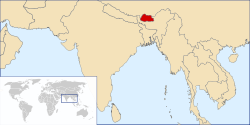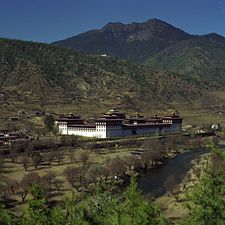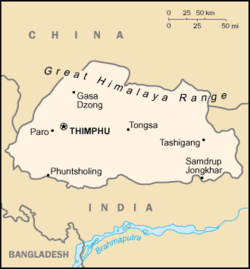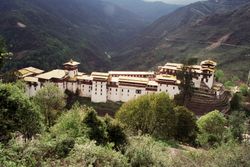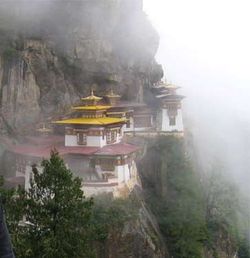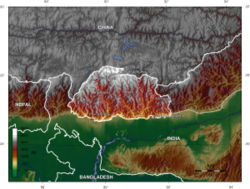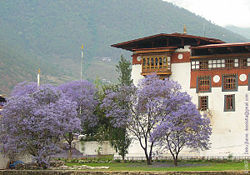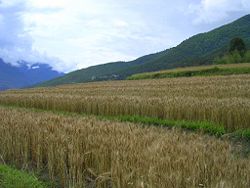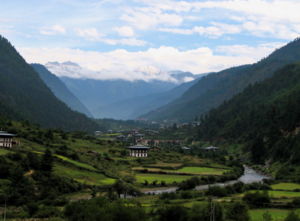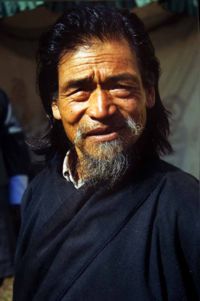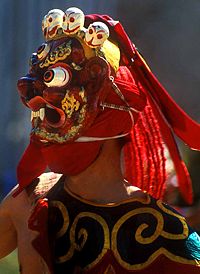Bhutan
2008/9 Schools Wikipedia Selection. Related subjects: Asia; Asian Countries
Brug rGyal-Khab ( Wylie) Dru Gäkhap Kingdom of Bhutan
|
||||||
|---|---|---|---|---|---|---|
|
||||||
| Anthem: Druk Tsendhen Koepay Gyelkhab ("The Glorious Dragon Kingdom of Bhutan") |
||||||
|
|
||||||
| Capital | Thimphu | |||||
| Official languages | Dzongkha | |||||
| Demonym | Bhutanese | |||||
| Government | Democracy, Constitutional Monarchy | |||||
| - | King | Jigme Khesar Namgyal Wangchuk | ||||
| - | Prime Minister | Jigme Thinley ( DPT) | ||||
| Formation | Early 17th century | |||||
| - | Wangchuk Dynasty | December 17, 1907 | ||||
| - | Constitutional Monarchy | 2008 | ||||
| Area | ||||||
| - | Total | 47,000 km² ( 131st) 18,147 sq mi |
||||
| - | Water (%) | Not available yet | ||||
| Population | ||||||
| - | estimate | 672,425 (2005)1 | ||||
| - | Density | 45/km² ( 154th) 117/sq mi |
||||
| GDP ( PPP) | 2007 estimate | |||||
| - | Total | $4.39 billion ( 160th) | ||||
| - | Per capita | $5,477 ( 117th) | ||||
| HDI (2007) | ▲ 0.579 (medium) ( 133th) | |||||
| Currency | Ngultrum ( BTN) |
|||||
| Time zone | BTT ( UTC+6:00) | |||||
| - | Summer ( DST) | not observed ( UTC+6:00) | ||||
| Internet TLD | .bt | |||||
| Calling code | +975 | |||||
| 1 | The population of Bhutan had been estimated based on the reported figure of about 1 million in the 1970s when the country had joined the United Nations and precise statistics were lacking . Thus using the annual increase rate of 2-3%, the most population estimates were around 2 million in the year 2000. A national census was carried out in 2005 and it turned out that the population was 672,425. Consequently, United Nations Population Division had down-estimated the country's population in the 2006 revision for the whole period from 1950 to 2050. | |||||
The Kingdom of Bhutan (IPA: /buːˈtɑːn/) is a landlocked nation in South Asia. It is located amid the eastern end of the Himalaya Mountains and is bordered to the south, east and west by India and to the north by China. Bhutan is separated from Nepal by the Indian state of Sikkim. The Bhutanese call their country འབྲུག་ཡུལ་, Druk Yul (land of the thunder dragon).
Bhutan is one of the most isolated and least developed nations in the world. Foreign influences and tourism are regulated by the government to preserve the nation's traditional culture, identity and the environment. In 2006, however, Business Week rated Bhutan the happiest country in Asia and the eighth happiest country in the world. The landscape ranges from subtropical plains in the south to the Himalayan heights in the north, with some peaks exceeding 7,000 metres (23,000 feet). The state religion is Vajrayana Buddhism, and the population is predominantly Buddhist, with Hinduism being the second-largest religion. The capital and largest city is Thimphu. After centuries of direct monarchic rule, Bhutan held its first democratic elections in March 2008. Bhutan is a member of the South Asian Association for Regional Cooperation (SAARC).
Name
"Bhutan" may be derived from the Sanskrit word Bhu-Utthan (highlands). In another theory of Sanskritisation, Bhots-ant means "End of Tibet", as Bhutan is immediately to Tibet's south.
Historically Bhutan was known by many names, such as Lho Mon (southern land of darkness), Lho Tsendenjong (southern land of the Tsenden cypress), Lhomen Khazhi (southern land of four approaches) and Lho Men Jong (southern land of medicinal herbs). Bhutan is also commonly known as The Last Shangrila.
History
Stone tools, weapons, elephants, and remnants of large stone structures provide evidence that Bhutan was inhabited as early as 2000 BCE, although there are no existing records from that time. Historians have theorized that the state of Lhomon (literally, "southern darkness"), or Monyul ("Dark Land", a reference to the Monpa, the aboriginal peoples of Bhutan) may have existed between 500 BCE and 600 CE.The names Lhomon Tsendenjong ( Sandalwood Country), and Lhomon Khashi, or Southern Mon (country of four approaches) have been found in ancient Bhutanese and Tibetan chronicles.
The earliest transcribed event in Bhutan was the passage of the Buddhist saint Padma Sambhava (also known as Guru Rinpoche) in 747. Bhutan's early history is unclear, because most of the records were destroyed after fire ravaged the ancient capital, Punakha, in 1827. By the 10th century, Bhutan's political development was heavily influenced by its religious history. However, there is no sufficient information stating that all historical records were available before the fire. Various sub-sects of Buddhism emerged which were patronised by the various Mongol and Tibetan overlords. After the decline of the Mongols in the 14th century, these sub-sects vied with each other for supremacy in the political and religious landscape, eventually leading to the ascendancy of the Drukpa sub-sect by the 16th century.
Until the early 17th century, Bhutan existed as a patchwork of minor warring fiefdoms, when the area was unified by the Tibeten lama and military leader Shabdrung Ngawang Namgyal. To defend the country against intermittent Tibetan forays, Namgyal built a network of impregnable dzong (fortresses), and promulgated a code of law that helped to bring local lords under centralised control. Many such dzong still exist. After Namgyal's death in 1651, Bhutan fell into civil war. Taking advantage of the chaos, the Tibetans attacked Bhutan in 1710, and again in 1730 with the help of the Mongols. Both assaults were successfully thwarted, and an armistice was signed in 1759.
In the 18th century, the Bhutanese invaded and occupied the kingdom of Cooch Behar to the south. In 1772, Cooch Behar appealed to the British East India Company who assisted them in ousting the Bhutanese, and later in attacking Bhutan itself in 1774. A peace treaty was signed in which Bhutan agreed to retreat to its pre-1730 borders. However, the peace was tenuous, and border skirmishes with the British were to continue for the next 100 years. The skirmishes eventually led to the Duar War (1864–1865), a confrontation over who would control the Bengal Duars. After Bhutan lost the war, the Treaty of Sinchula was signed between British India and Bhutan. As part of the war reparations, the Duars were ceded to the United Kingdom in exchange for a rent of Rs. 50,000. The treaty ended all hostilities between British India and Bhutan.
During the 1870s, power struggles between the rival valleys of Paro and Tongsa led to civil war in Bhutan, eventually leading to the ascendancy of Ugyen Wangchuck, the ponlop (governor) of Tongsa. From his power base in central Bhutan, Ugyen Wangchuck defeated his political enemies and united the country following several civil wars and rebellions in the period 1882–1885.
In 1907, an epochal year for the country, Ugyen Wangchuck was unanimously chosen as the hereditary king of the country by an assembly of leading Buddhist monks, government officials, and heads of important families. The British government promptly recognised the new monarchy, and in 1910 Bhutan signed a treaty which "let" Great Britain "guide" Bhutan's foreign affairs. In reality, this did not mean much given Bhutan's historical reticence. It also did not seem to apply to Bhutan's traditional relations with Tibet. The greatest impact of this treaty seems to be the perception that it meant Bhutan was not totally sovereign.
After India gained independence from the United Kingdom on August 15, 1947, Bhutan became one of the first countries to recognise India's independence. A treaty similar to the one of 1910 was signed August 8, 1949 with the newly independent India.
In 1953, King Jigme Dorji Wangchuck established the country's legislature – a 130-member National Assembly – to promote a more democratic form of governance. In 1965, he set up a Royal Advisory Council, and in 1968 he formed a Cabinet. In 1971, Bhutan was admitted to the United Nations, having held observer status for three years. In July 1972, Jigme Singye Wangchuck ascended to the throne at the age of 16 after the death of his father, Dorji Wangchuck.
In the 1980s, in order to strengthen Bhutan’s identity as a nation, the "one nation, one people" campaign was started to foster greater integration of the peripheral ethnic and cultural groups into mainstream Bhutanese society. The age-old code of conduct, known as Driglam namzha, and usage of the official national language, Dzongkha, was promoted. At around the same time, a nationwide census revealed a large population of Nepali origin in southern Bhutan. When the government attempted to remove what it considered as illegal settlers, there was a violent backlash; numerous acts of terrorism were carried out against government schools, hospitals, offices and neutral southern Bhutanese. In order to re-establish order in the south, the government drafted many young men and able-bodied civil servants into a militia force. Thousands of civilians, including a number of political dissidents, were expelled or fled to Nepal, where they were admitted into United Nations-run camps and given refugee status. Despite the best efforts of the Bhutanese government Nepal and India, as well as outside parties such as the United Nations, the European Union and the United States, a viable solution to this problem proves to be still elusive. At present, the United States is working towards resettling around 70,000 of these refugees in the US.
In 1998, King Jigme Singye Wangchuck introduced significant political reforms, transferring most of his administrative powers to the Council of Cabinet Ministers and allowing for impeachment of the King by a two-thirds majority of the National Assembly. In late 2003, the Bhutanese army successfully launched a large-scale operation to flush out anti-India insurgents who were operating training camps in southern Bhutan.
In 1999, the government lifted a ban on television and the Internet, making Bhutan one of the last countries to introduce television. In his speech, the King said that television was a critical step to the modernisation of Bhutan as well as a major contributor to the country's Gross National Happiness (Bhutan is the only country to measure happiness), but warned that the "misuse" of television could erode traditional Bhutanese values.
A new constitution was presented in early 2005. In December 2005, Jigme Singye Wangchuck announced that he would abdicate the throne in his son's favour in 2008. On December 14, 2005, he announced that he would be abdicating immediately. Bhutan has now entered a new era of democracy, starting with its first national parliamentary elections in December 2007 and March 2008.
Government and politics
Over the past decade, Bhutan's political system has developed from an absolute monarchy into a constitutional monarchy. In 1999, the fourth king of Bhutan created a body called the Lhengye Zhungtshog (Council of Ministers). The 'Druk Gyalpo' (King of Druk Yul) is head of state. Executive power is exercised by the Lhengye Zhungtshog, the council of ministers. Legislative power was vested in both the government and the former Grand National Assembly. On the 17th of December 2005, the 4th King, Jigme Singye Wangchuck, announced to a stunned nation that the first general elections would be held in 2008, and that he would abdicate the throne in favour of his eldest son, the crown prince. King Jigme Khesar Namgyal Wangchuck took the throne on December 14, 2006 upon his father's abdication. The Crowning ceremony is expected to be held in May 2008 and the Coronation Celebrations later in the year.
The new democratic system comprises an upper and lower house, the latter based on political party affiliations. Elections for the upper house ( National Council) were held on December 31, 2007, while elections for the lower house, the 47-seat National Assembly, were held on March 24, 2008. Two political parties, the People's Democratic Party (PDP) headed by Sangay Ngedup, and the Druk Phuensum Tshogpa (DPT) headed by Jigmi Thinley, competed in the National Assembly election. The Druk Phuensum Tshogpa won the elections taking 45 out of 47 seats in the parliament.
Judicial power is vested in the courts of Bhutan. The Chief Justice is the administrative head of the Judiciary.
Military and foreign affairs
The Royal Bhutan Army is Bhutan's military service. It includes the Royal Bodyguard and the Royal Bhutan Police. Membership is voluntary, and the minimum age for recruitment is 18. The standing army numbers about 6,000 and is trained by the Indian Army. It has an annual budget of about US$13.7 million — 1.8 percent of the GDP.
Though the 1949 treaty with India is still sometimes misinterpreted to mean that India controlled Bhutan's foreign affairs, Bhutan handled all of its foreign affairs itself including the sensitive (to India) border demarcation issue with China. The 1949 treaty has been superseded by the 2007 treaty with India which made de-jure what was de-facto, that Bhutan was master of its own foreign relations. Bhutan has diplomatic relations with 22 countries, including the European Union, with missions in India, Bangladesh, Thailand, and Kuwait. It has two UN missions, one in New York and one in Geneva. Only India and Bangladesh have residential embassies in Bhutan, while Thailand has a consulate office in Bhutan.
By a long standing treaty, Indian and Bhutanese citizens may travel to each other's countries without a passport or visa using their national identity cards instead. Bhutanese citizens may also work in India without legal restriction. Bhutan does not have formal diplomatic ties with its northern neighbour, China, although exchanges of visits at various levels between the two have significantly increased in the recent past. The first bilateral agreement between China and Bhutan was signed in 1998, and Bhutan has also set up consulates in Macau and Hong Kong. Bhutan’s border with China is largely not demarcated and thus disputed in some places.
On November 13, 2005, Chinese soldiers crossed into Bhutan under the pretext that environmental conditions had forced their retreat south from the Himalayas. The Bhutanese government allowed this incursion (after the fact) on humanitarian grounds. Soon after, the Chinese began building roads and bridges within Bhutanese territory. Bhutanese Foreign Minister Khandu Wangchuk took up the matter with Chinese authorities after the issue was raised in Bhutanese parliament. In response, Foreign Ministry spokesman Qin Gang of the People's Republic of China has said that the border remains in dispute and that the two sides continue to work for a peaceful and cordial resolution of the dispute. An Indian intelligence officer has said that a Chinese delegation in Bhutan told the Bhutanese that they were "overreacting." The Bhutanese newspaper Kuensel has said that China might use the roads to further Chinese claims along the border.
On February 8, 2007, the Indo-Bhutan Friendship Treaty PDF (30.6 KiB) was substantially revised. Whereas in the Treaty of 1949 Article 2 read as "The Government of India undertakes to exercise no interference in the internal administration of Bhutan. On its part the Government of Bhutan agrees to be guided by the advice of the Government of India in regard to its external relations."
In the revised treaty it now reads as "In keeping with the abiding ties of close friendship and cooperation between Bhutan and India, the Government of the Kingdom of Bhutan and the Government of the Republic of India shall cooperate closely with each other on issues relating to their national interests. Neither government shall allow the use of its territory for activities harmful to the national security and interest of the other." The revised treaty also includes in it the preamble "Reaffirming their respect for each other's independence, sovereignty and territorial integrity", an element that was absent in the earlier version. The Indo-Bhutan Friendship Treaty of 2007 strengthens Bhutan's status as an independent and sovereign nation.
Bhutan has no formal relations with the United States, Russia, the United Kingdom or France. Informal contact with the United States is made through the U.S. embassy in New Delhi.
Geography
The northern region consists of an arc of glaciated mountain peaks with an extremely cold climate at the highest elevations. Most peaks in the north are over 23,000 feet (7,000 m) above sea level; the highest point is claimed to be the Kula Kangri, at 24,780 feet (7,553 m), but detailed topographic studies claim Kula Kangri is wholly in Tibet and modern Chinese measurements claim that Gangkhar Puensum, which has the distinction of being the highest unclimbed mountain in the world, is higher at 24,835 feet (7,570 m). Watered by snow-fed rivers, alpine valleys in this region provide pasture for livestock, tended by a sparse population of migratory shepherds.
The Black Mountains in central Bhutan form a watershed between two major river systems: the Mo Chhu and the Drangme Chhu. Peaks in the Black Mountains range between 4,900 feet and 8,900 feet (1,500 m and 2,700 m) above sea level, and fast-flowing rivers have carved out deep gorges in the lower mountain areas. Woodlands of the central region provide most of Bhutan's forest production. The Torsa, Raidak, Sankosh, and Manas are the main rivers of Bhutan, flowing through this region. Most of the population lives in the central highlands.
In the south, the Shiwalik Hills are covered with dense, deciduous forests, alluvial lowland river valleys, and mountains up to around 4,900 feet (1,500 m) above sea level. The foothills descend into the subtropical Duars Plain. Most of the Duars is located in India, although a 6–9 mile (10–15 km) wide strip extends into Bhutan. The Bhutan Duars is divided into two parts: the northern and the southern Duars. The northern Duars, which abuts the Himalayan foothills, has rugged, sloping terrain and dry, porous soil with dense vegetation and abundant wildlife. The southern Duars has moderately fertile soil, heavy savannah grass, dense, mixed jungle, and freshwater springs. Mountain rivers, fed by either the melting snow or the monsoon rains, empty into the Brahmaputra River in India. Data released by the Ministry of Agriculture showed that the country had a forest cover of 64% as of October 2005.
The climate in Bhutan varies with altitude, from subtropical in the south to temperate in the highlands and polar-type climate, with year-round snow, in the north. Bhutan experiences five distinct seasons: summer, monsoon, autumn, winter and spring. Western Bhutan has the heavier monsoon rains; southern Bhutan has hot humid summers and cool winters; central and eastern Bhutan is temperate and drier than the west with warm summers and cool winters.
Economy
The Ngultrum is the currency of Bhutan and its value is pegged to the Indian rupee. The rupee is also accepted as legal tender in the country.
Though Bhutan's economy is one of the world's smallest, it has grown rapidly in recent years, by eight percent in 2005 and 14 percent in 2006. This was mainly due to the commissioning of the gigantic Tala Hydroelectricity project. As of March 2006, Bhutan's per capita income was US$1,321.
Bhutan's economy is based on agriculture, forestry, tourism and the sale of hydroelectric power to India. Agriculture provides the main livelihood for more than 80 percent of the population. Agrarian practices consist largely of subsistence farming and animal husbandry. Handicrafts, particularly weaving and the manufacture of religious art for home altars, are a small cottage industry. A landscape that varies from hilly to ruggedly mountainous has made the building of roads and other infrastructure difficult and expensive. This, and a lack of access to the sea, has meant that Bhutan has not been able to benefit from significant trading of its produce. Bhutan does not have any railways, though Indian Railways plans to link southern Bhutan to its vast network under an agreement signed in January 2005. The historic trade routes over the high Himalayas, which connected India to Tibet, have been closed since the 1959 military takeover of Tibet (although smuggling activity still brings Chinese goods into Bhutan).
The industrial sector is in a nascent stage, and though most production is cottage industry type larger industries are being encouraged and some industries such as cement, steel, ferro alloy, etc., have been set up. Most development projects, such as road construction, rely on Indian contract labour. Agricultural produce includes rice, chilies, dairy (some yak, mostly cow) products, buckwheat, barley, root crops, apples, and citrus and maize at lower elevations. Industries include cement, wood products, processed fruits, alcoholic beverages and calcium carbide.
Incomes of over Nu 100,000 per annum are taxed, but very few wage and salary earners qualify. Bhutan's inflation rate was estimated at about three percent in 2003. Bhutan has a Gross Domestic Product of around USD 2.913 billion (adjusted to Purchasing Power Parity), making it the 162nd largest economy in the world.
Per capita income is around $1,400 , ranked 124th. Government revenues total $272 million, though expenditures amount to $350 million. 60 percent of the budget expenditure, however, is financed by India's Ministry of External Affairs. Bhutan's exports, principally electricity, cardamom, gypsum, timber, handicrafts, cement, fruit, precious stones and spices, total €128 million (2000 est.). Imports, however, amount to €164 million, leading to a trade deficit. Main items imported include fuel and lubricants, grain, machinery, vehicles, fabrics and rice. Bhutan's main export partner is India, accounting for 87.9 percent of its export goods. Bangladesh (4.6 percent) and the Philippines (two percent) are the other two top export partners. As its border with Tibet is closed, trade between Bhutan and China is now almost non-existent. Bhutan's import partners include India (71.3 percent), Japan (7.8 percent) and Austria (three percent).
In a response to accusations in 1987 by a journalist from UK's Financial Times that the pace of development in Bhutan was slow, the King said that " Gross National Happiness is more important than Gross National Product." This statement appears to have presaged recent findings by western economic psychologists, including 2002 Nobel Laureate Daniel Kahneman, that question the link between levels of income and happiness. The statement signaled his commitment to building an economy that is appropriate for Bhutan's culture, based on Buddhist spiritual values, and has served as a unifying vision for the economy. In a survey in 2005, 45 percent of Bhutanese reported being very happy, 52 percent reported being happy and only three percent reported not being happy. Based on this data, the Happy Planet Index estimates that the average level of life satisfaction in Bhutan is within the top 10 percent of nations worldwide, and certainly higher than other nations with similar levels of GDP per capita.
Districts
Bhutan is divided into four dzongdey (administrative zones). Each dzongdey is further divided into dzongkhag (districts). There are twenty dzongkhag in Bhutan. Large dzongkhags are further divided into subdistricts known as dungkhag. At the basic level, groups of villages form a constituency called gewog and are administered by a gup, who is elected by the people.
|
|
Cities and towns
- Jakar, the administrative headquarters of Bumthang District and the place where Buddhism entered Bhutan.
- Mongar, the eastern commercial hub of the country.
- Paro, Bhutan, site of the international airport.
- Punakha, the old capital.
- Phuentsholing, Bhutan's commercial hub.
- Samdrup Jongkhar
- Thimphu, the largest city and capital of Bhutan.
- Trashigang, the most populous district in the country.
- Trongsa, in central Bhutan which has the largest and the most magnificent of all the dzongs in Bhutan.
Demographics
Among the Bhutanese people, several principal ethnic groups may be distinguished. The second dominant group is the Ngalops, a Buddhist group based in the western part of the country. Their culture is closely related to that of Tibet. Much the same could be said of the Sharchops ("Easterners"), the dominant group, who are associated with the eastern part of Bhutan (but who traditionally follow the Nyingmapa rather than the official Drukpa Kagyu form of Himalayan Buddhism). They are called the Western Bhutanese and Eastern Bhutanese respectively. In modern times, with improved transportation infrastructure, there has been much intermarriage between these groups. In the early 1970s, intermarriage between the Lhotshampas and main stream Bhutanese society was encouraged by the government.
The national language is Dzongkha, one of 53 languages in the Tibetan language family. The script, here called Chhokey ("Dharma Language"), is identical to classical Tibetan. In the schools English is the medium of instruction and Dzongkha is taught as the national language. Ethnologue lists 24 languages currently spoken in Bhutan, all of them in the Tibeto-Burman family, except Nepali, an Indo-Aryan language. Until the 1980s, the government sponsored the teaching of Nepali in schools in Southern Bhutan. However, after the armed uprising in the south, Nepali was dropped from the curriculum. The languages of Bhutan are still not well-characterized, and several have yet to be recorded in an in-depth academic grammar.
| Religions of Bhutan | ||||
|---|---|---|---|---|
| religion | percent | |||
| Buddhism | 75% | |||
| Hinduism | 24% | |||
| Others | 1% | |||
The literacy rate is 59.5 percent. The country has a median age of 22.3 years. Bhutan has a life expectancy of 62.2 years (61 for males and 64.5 for females) according to the latest data from the World Bank. There are 1,070 males to every 1,000 females in the country.
It is estimated that between two third and three quarter of the Bhutanese population follow Mahayana Buddhism, which is also the state religion. About one quarter to one third are followers of Hinduism. Muslim and non-religious communities account for less than 1 % of the population. The current legal framework in principal guarantees freedom of religion; Proselytism, however, is forbidden by a Royal Government decision.
Culture
Bhutan has a rich and unique cultural heritage that has largely remained intact due to its isolation from the rest of the world until the early 1960s. One of the main attractions for tourists is the country's culture and traditions. Bhutanese tradition is deeply steeped in its Buddhist heritage. Hinduism is the second dominant religion in Bhutan, being most prevalent in the southern regions. Both religions co-exist peacefully and receive support from the government, and enjoy royal patronage. The government is increasingly making efforts to preserve and sustain the current culture and traditions of the country. Due to its largely unspoilt natural environment and cultural heritage, Bhutan has aptly been referred to as The Last Shangri-la.
While the Bhutanese are free to travel abroad, Bhutan is seen to be inaccessible to many foreigners. There is a widespread misconception that Bhutan has set limits on tourist visas. However, it is the high tourist tariff and requirement to go on packaged tours that makes Bhutan an exclusive tourist destination.
The National Dress for Bhutanese men is the gho, a knee-length robe tied at the waist by a cloth belt known as the kera. Women wear an ankle-length dress, the kira, which is clipped at one shoulder and tied at the waist. An accompaniment to the kira is a long-sleeved blouse, the toego, which is worn underneath the outer layer. Social status and class determine the texture, colours, and decorations that embellish the garments. Differently coloured scarves and shawls are important indicators of social standing, as Bhutan has traditionally been a feudal society. Jewellery is mostly worn by women, especially during religious festivals and public gatherings. To strengthen Bhutan's identity as an independent country, Bhutanese law requires all Bhutanese citizens to wear the national dress in public areas and as formal wear.
Rice, buckwheat, and increasingly maize, are the staple foods of the country. The diet also includes pork, beef, yak meat, chicken, and mutton. Soups and stews of meat and dried vegetables spiced with chillies and cheese are prepared. Ema datshi, made very spicy with cheese and chilies, might be called the national dish for its ubiquity and the pride that Bhutanese have for it. Dairy foods, particularly butter and cheese from yaks and cows, are also popular, and indeed almost all milk is turned to butter and cheese. Popular beverages include butter tea, tea, locally brewed rice wine and beer. Bhutan is the only country in the world to have banned the sale of tobacco.
Bhutan's national sport is archery, and competitions are held regularly in most villages. It differs from Olympic standards not only in technical details such as the placement of the targets and atmosphere. There are two targets placed over 100 meters apart and teams shoot from one end of the field to the other. Each member of the team shoots two arrows per round. Traditional Bhutanese archery is a social event and competitions are organized between villages, towns, and amateur teams. There are usually plenty of food and drink complete with singing and dancing. Attempts to distract an opponent include standing around the target and making fun of the shooter's ability. Darts (khuru) is an equally popular outdoor team sport, in which heavy wooden darts pointed with a 10 cm nail are thrown at a paperback-sized target ten to 20 meters away.
Another traditional sport is the digor, which can be best described as shot put combined with horseshoe throwing. Cricket has gained remarkable popularity in Bhutan, especially since the heavy influx of Indian Television. Their national cricket team is one of the more successful associate nations in the region. Football is an increasingly popular sport. In 2002, Bhutan's national football team played Montserrat - billed as The Other Final, the match took place on the same day Brazil played Germany in the World Cup Final, but at the time Bhutan and Montserrat were the world's two lowest ranked teams. The match was held in Thimphu's Changlimithang National Stadium, and Bhutan won 4-0. A documentary of the match was made by the Dutch filmmaker Johan Kramer.
Rigsar is the new emergent style of popular music, played on a mix of traditional instruments and electronic keyboards, and dates back to the early 1990s; it shows the influence of Indian popular music, a hybrid form of traditional and Western popular influences. Traditional genres include the zhungdra and boedra.
Characteristic of the region is a type of castle fortress known as the dzong. Since ancient times, the dzongs have served as the religious and secular administration centres for their respective districts.
Bhutan has numerous public holidays, most of which centre around traditional seasonal, secular and religious festivals. They include the winter solstice (around January 1, depending on the lunar calendar), the lunar New Year (February or March), the King's birthday and the anniversary of his coronation, the official start of monsoon season (September 22), National Day (December 17), and various Buddhist and Hindu celebrations.
Masked dances and dance dramas are common traditional features at festivals, usually accompanied by traditional music. Energetic dancers, wearing colourful wooden or composition face masks and stylized costumes, depict heroes, demons, dæmons, death heads, animals, gods, and caricatures of common people. The dancers enjoy royal patronage, and preserve ancient folk and religious customs and perpetuate the ancient lore and art of mask-making.
Inheritance in Bhutan generally goes in the female rather than the male line. Daughters will inherit their parents' house. A man is expected to make his own way in the world and often moves to his wife's home. Love marriages are common in urban areas, but the tradition of arranged marriages is still common in the villages. Although uncommon, polygamy and polyandry are accepted; often being a device to keep property in a contained family unit rather than dispersing it.


